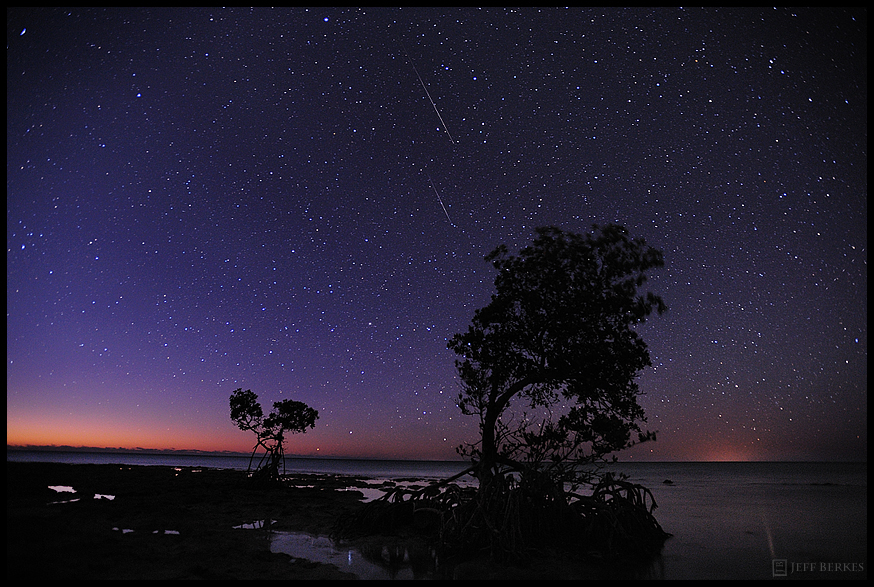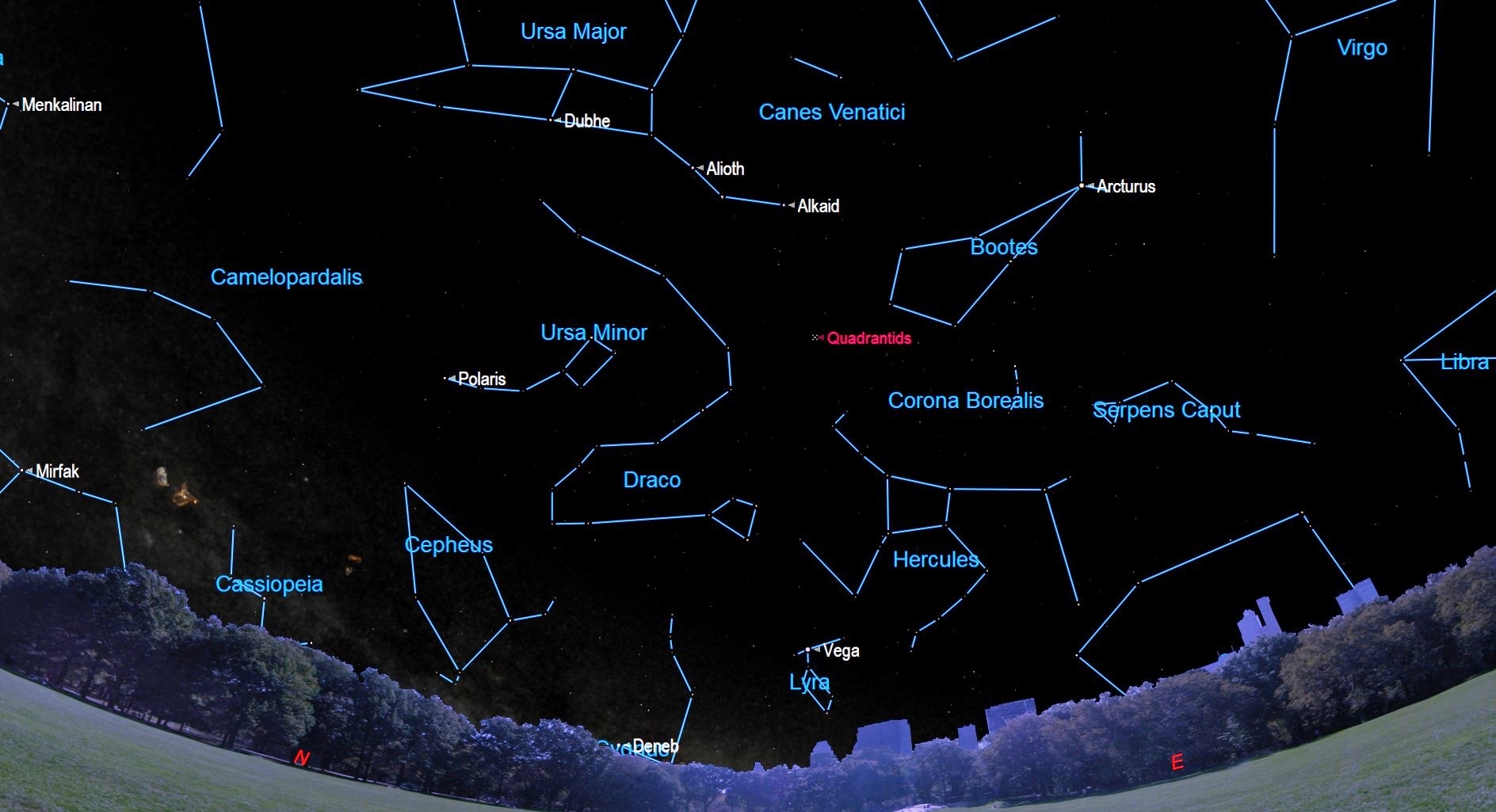The Quadrantid meteor shower, usually one of the best, peaks at the wrong time this weekend

Early each January, the Quadrantid meteor shower provides one of the most intense annual meteor displays, with its brief, sharp peak — which only lasts just a few hours — coming this year overnight on Saturday and Sunday (Jan. 2-3).
The meteors actually radiate from the northeast corner of the constellation of Boötes, the Herdsman, so we might expect them to be called the "Boötids." But back in the late 18th century there was a constellation here called Quadrans Muralis, the "Mural or Wall Quadrant" (an astronomical instrument). It is a long-obsolete star pattern, invented in 1795 by J.J. Lalande to commemorate the instrument used to observe the stars in his catalogue.
Adolphe Quetelet of Brussels Observatory discovered the shower in the 1830s, and shortly afterward it was noted by several astronomers in Europe and America. Thus, they were christened "Quadrantids" (pronounced KWA-dran-tids) and even though the constellation from which these meteors appear to radiate no longer exists, the shower’s original moniker continues to this day.
Related: Quadrantid meteor shower 2021 guide: When and how to see it
More: The 10 must-see night sky events to see in 2021
2021: A Poor Quad Year
Unfortunately, this will not be a good year to look for the "Quads" for two reasons. Chalk it up simply to poor timing.
First, the peak of this year's shower is predicted for either 10 a.m. EST or 7 a.m. EST on Jan. 3. So, across the contiguous U.S. and southern Canada, maximum activity will come during bright morning twilight or daylight conditions. Remember what we said: this is a sharply peaked display, so six hours before the peak activity will only be about a one-half of its maximum rate. For the eastern U.S., hourly rates of 30 to 60 meteors per hour are possible, while for the western U.S., hourly rates might reach 45 to 90; still excellent numbers so far as most meteor showers go.
But unfortunately, there's a far bigger stumbling block for prospective meteor watchers this year in the form of the moon. In one out of every three years, bright moonlight spoils the view and this is one of those years.
Breaking space news, the latest updates on rocket launches, skywatching events and more!
In 2021, the moon turns full five days before the peak of the shower. That means that on the morning of Jan. 3, there is going to be a bright waning gibbous moon, 81% illuminated, situated in the constellation Leo the Lion, that will be reaching its highest point in the sky at about half past three in the morning.
So, all through the overnight hours of Saturday and into Sunday (Jan. 2-3), the sky will be lit up with brilliant moonlight. That moonlight will likely squelch all but the brightest of meteors. This particular meteor display is at its best just before the break of dawn — about 6 a.m. local time — when the radiant of this shower, from which the meteors appear to emanate, is ascending the northeastern sky.
So, factoring that bright moon in means that if you live in the eastern U.S., you may not see more than a half dozen of these blue streakers during a single hour. Out west, it might be a little better; you might catch sight of about 10 or so Quads per hour.
Related: Amazing Quadrantid meteor shower photos by stargazers
Crumbs of a dead comet?
At greatest activity, 60 to 120 Quadrantid meteors per hour are usually seen. However, the Quadrantid influx is sharply peaked: six hours before and after maximum, these blue meteors appear at one-half of their highest rates.So, the stream of particles that produce this shower is a narrow one — apparently derived within the last 500 years from a small comet.
The parentage of the Quadrantids had long been a mystery. Then, Dr. Peter Jenniskens, an astronomer at the SETI Institute in Mountain View, California, noticed that the orbit of 2003 EH1 — a small asteroid discovered in March 2003 — ''falls snug in the shower.'' He believes that this 1.2-mile. (2 kilometers) chunk of rock is the source of the Quadrantids; possibly this asteroid is the burnt-out core of the lost comet C/1490 Y1.
As viewed from mid-northern latitudes, we have to get up before dawn to see the Quadrantids at their best. This is because the radiant – that part of the sky from where the meteors to emanate — is down low on the northern horizon until about midnight, rising slowly higher as the night progresses. The growing light of dawn ends meteor observing usually by around 6 a.m. So, if the "Quads" are to be seen at all, some part of that six-hour active period must fall between 2 and 6 a.m.
Stay warm and "shower" with a friend
Lastly — and I've touched on this point many times before, but certainly it should be addressed again — your local weather will likely be more appropriate for taking in a hot bath as opposed to a winter meteor shower. Indeed, at this time of year meteor watching can be a long, cold business. You wait and you wait for meteors to appear and when they don't appear right away, and if you're cold and uncomfortable, you're not going to be looking for meteors for very long! Therefore, make sure you're warm and comfortable.
Warm cocoa or coffee can take the edge off the chill, as well as provide a slight stimulus. It's even better if you can observe with friends. That way, you can cover more sky.
Good luck and clear skies!
Joe Rao serves as an instructor and guest lecturer at New York's Hayden Planetarium. He writes about astronomy for Natural History magazine, the Farmers' Almanac and other publications. Follow us on Twitter @Spacedotcom and on Facebook.

Joe Rao is Space.com's skywatching columnist, as well as a veteran meteorologist and eclipse chaser who also serves as an instructor and guest lecturer at New York's Hayden Planetarium. He writes about astronomy for Natural History magazine, Sky & Telescope and other publications. Joe is an 8-time Emmy-nominated meteorologist who served the Putnam Valley region of New York for over 21 years. You can find him on Twitter and YouTube tracking lunar and solar eclipses, meteor showers and more. To find out Joe's latest project, visit him on Twitter.

